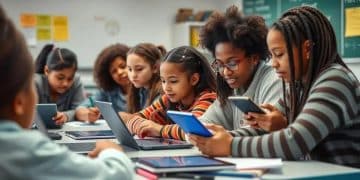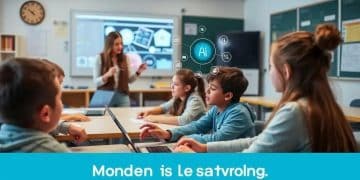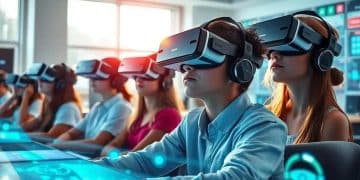School technology integration trends shaping the future
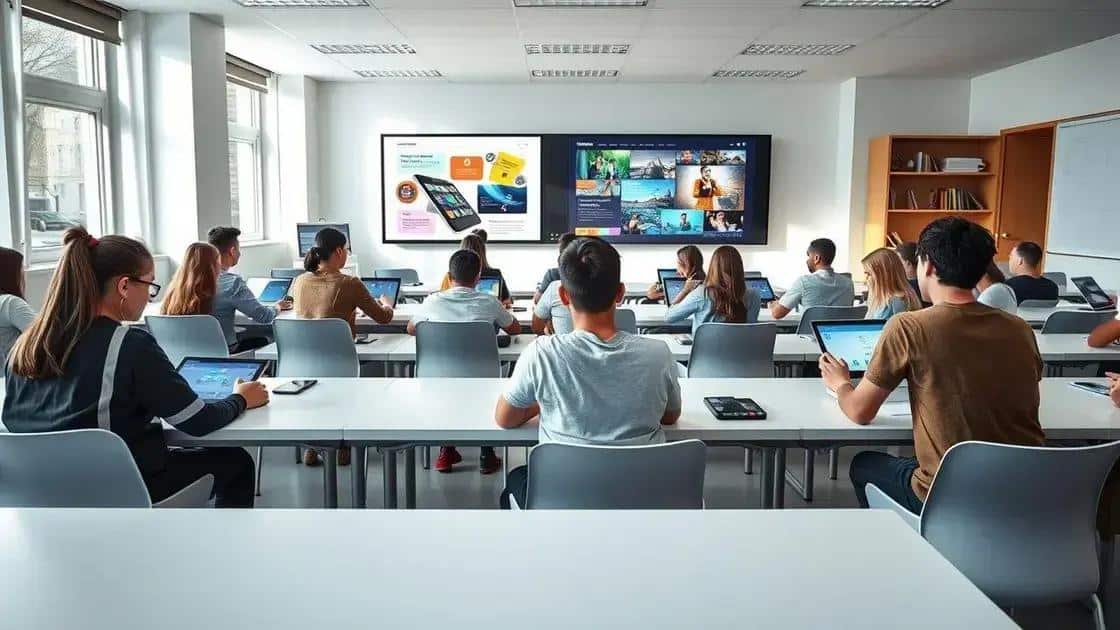
School technology integration trends involve the use of AI, virtual reality, and personalized learning to enhance educational experiences while addressing challenges like funding and digital literacy.
School technology integration trends are changing how students learn and interact in the classroom. Have you ever wondered how technology might redefine education’s landscape? This article dives into the latest trends and their implications for both students and teachers.
Current trends in school technology integration
Understanding the current trends in school technology integration can help educators enhance learning experiences. Technology plays a crucial role in today’s classrooms, enabling a more interactive and engaging environment for students.
1. Increased Use of Digital Tools
Schools are increasingly adopting digital tools such as educational apps, online platforms, and multimedia resources. These tools not only aid in lesson delivery but also cater to various learning styles and needs.
2. Focus on Personalized Learning
With technology, personalized learning is becoming more accessible. Educators can utilize data analytics to track student progress and tailor learning experiences. This approach ensures that each student receives the attention they need to succeed.
- Adapting lessons based on individual performance.
- Providing resources that match students’ skills and interests.
- Maintaining engagement through interactive content.
Moreover, students are encouraged to take ownership of their learning. For instance, they can choose projects that interest them, promoting deeper engagement and motivation.
3. Emphasis on Collaboration
Another trend is fostering collaboration among students using technology. Tools like Google Classroom and other educational platforms facilitate group work and peer feedback. This collaborative approach not only builds teamwork skills but also encourages diverse perspectives in problem-solving.
By integrating technology, classrooms are also becoming more inclusive. Students with various needs can benefit from adaptive technologies that support learning for everyone. It’s exciting to see schools invest in tools that cater to differing abilities, making education more equitable.
Furthermore, teachers are evolving their teaching methods. Professional development programs focus on equipping educators with the skills they need to effectively use these technologies in their teaching.
4. Growing Importance of Cybersecurity
As schools embrace technology, cybersecurity has become a priority. Protecting student data and ensuring safe online environments is crucial. Schools are now implementing stronger security measures and educating students about digital safety practices.
In summary, the trends in technology integration directly impact how educators teach and how students learn. By focusing on digital tools, personalization, collaboration, and cybersecurity, schools are shaping a brighter future for education.
Benefits of integrating technology in classrooms
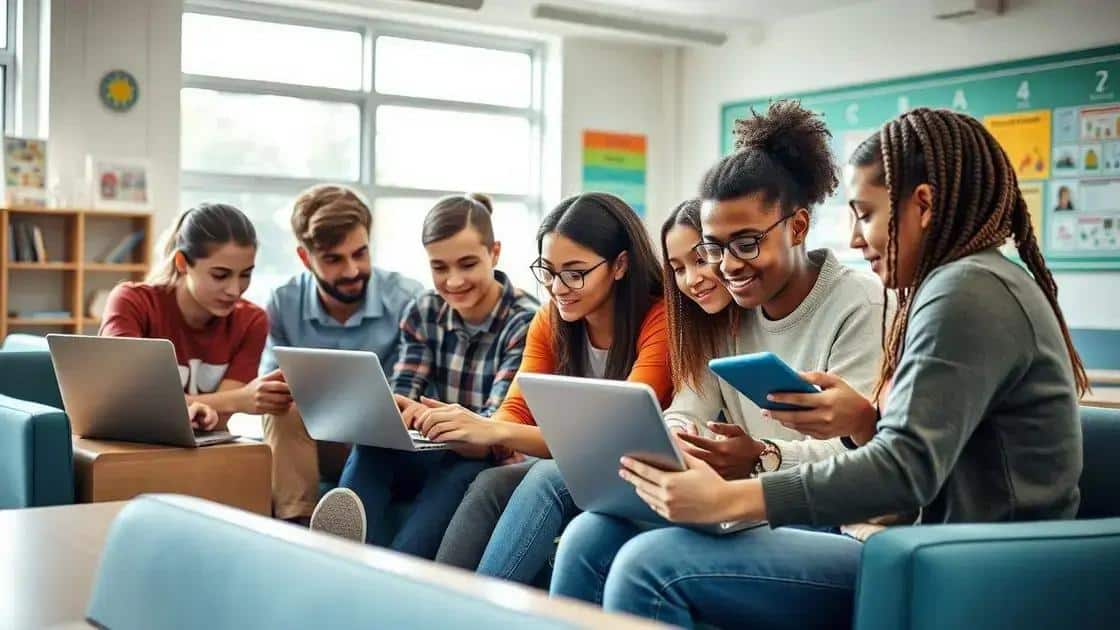
The benefits of integrating technology in classrooms are significant and can lead to improved learning outcomes. Technology enhances the teaching process and makes learning more engaging for students.
1. Enhanced Engagement
Using technology in the classroom helps capture students’ attention. Interactive tools like smartboards and educational apps create a dynamic learning environment. With these resources, lessons become more interesting, leading students to participate actively.
2. Access to Resources
Integrating technology provides access to vast resources. Students can explore information online, watch instructional videos, or read about topics in depth. This accessibility encourages independent research and learning beyond the classroom.
- Access to digital libraries and databases.
- Ability to connect with experts and guest speakers worldwide.
- Use of multimedia content to deepen understanding.
Moreover, teachers can blend different media in their lessons. For instance, they can combine text, video, and quizzes to make concepts clearer. This blend often caters to different learning styles, ensuring that every student finds a way to connect with the material.
3. Improved Collaboration
Collaborative tools enable students to work together easily, encouraging teamwork. Platforms such as Google Docs allow multiple students to contribute to projects simultaneously. This not only builds communication skills but also fosters a sense of community within the classroom.
Additionally, technology promotes peer-to-peer learning. Students can share knowledge and support each other, creating an environment where everyone benefits from collaboration. When students explain concepts to each other, they reinforce their understanding.
4. Personalized Learning
Integrating technology allows for personalized learning experiences. Using educational software, teachers can tailor assignments to meet individual student needs. This personalized approach helps students learn at their own pace, making the learning process less stressful.
Furthermore, technology can provide instant feedback. Students can see how they are progressing and identify areas for improvement. This immediate assessment helps them focus their efforts on specific skills that need work.
Ultimately, the benefits of integrating technology in classrooms can transform the way students learn. By enhancing engagement, providing access to resources, improving collaboration, and facilitating personalized learning, technology meets the diverse needs of today’s learners efficiently.
Challenges faced by schools in tech integration
The challenges faced by schools in tech integration are significant and can hinder the effective use of technology in the classroom. While technology offers numerous benefits, overcoming these obstacles is essential for successful implementation.
1. Limited Funding
One of the biggest challenges is often the lack of funding. Schools may struggle to afford the latest technology, software, or necessary staff training. Without adequate resources, it becomes hard to create an effective tech-integrated environment.
2. Resistance to Change
Many educators may feel hesitant to adopt new technologies. Some might be accustomed to traditional teaching methods and unsure about integrating tech into their practices. This resistance can slow down the process of adopting innovative tools.
- Fear of technology not working as intended.
- Lack of confidence in their tech skills.
- Concerns about the potential disruption to established routines.
Moreover, professional development programs can be inconsistent. Schools may not always provide adequate training, leaving teachers feeling unprepared to use new tools effectively.
3. Technical Issues
Another challenge schools face is technical issues. Not all devices will work seamlessly, and connectivity problems can arise. These issues can lead to frustration for both teachers and students. When technology fails, it may disrupt learning, causing teachers to revert to less effective methods.
Additionally, maintaining and updating technology takes time and effort. Schools need IT support to troubleshoot problems and ensure everything runs smoothly.
4. Varying Levels of Digital Literacy
In many classrooms, students come with varying levels of digital literacy. Some students may be tech-savvy, while others may struggle with even basic functions. This disparity can create challenges in the implementation of technology, as teachers must find ways to engage all students.
To address these differences, teachers must develop strategies that help all students keep up. They might need to provide additional support or resources for those who need it, which can add to their workload.
Ultimately, while schools recognize the importance of technology integration, they must address these challenges to reap the full benefits of tech in the classroom. By overcoming funding issues, resistance to change, technical glitches, and varying digital skills, schools can create a robust learning environment.
Future outlook for technology in education
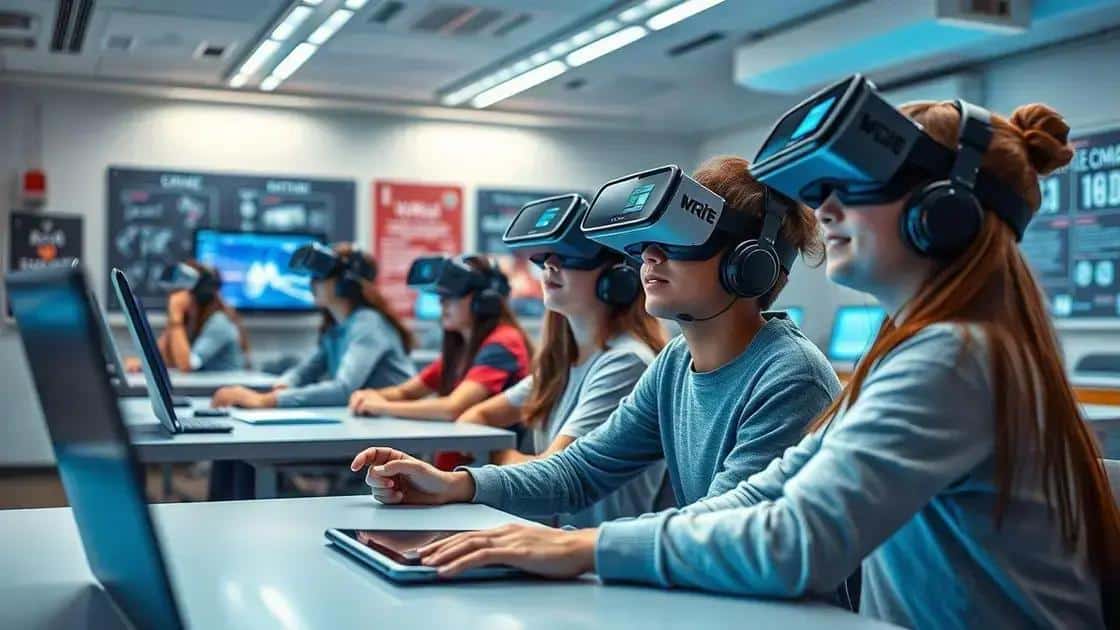
The future outlook for technology in education is promising, as innovations continue to shape classroom experiences. As schools adapt, technology will play a key role in enhancing learning and teaching methods.
1. Increased Use of Artificial Intelligence
AI will become integral in personalized education. By analyzing student data, AI can help tailor learning experiences to individual needs. This means students may receive customized lessons that match their learning pace and styles. AI can also assist teachers in grading and providing feedback more efficiently.
2. Virtual and Augmented Reality
Virtual and augmented reality (VR and AR) will revolutionize how students interact with content. These technologies create immersive learning experiences, allowing students to explore subjects like history and science in engaging ways. Imagine studying ancient civilizations by virtually walking through them, or conducting experiments in a realistic lab setting.
- Hands-on experience in a safe environment.
- Enhanced understanding through visual and sensory engagement.
- Increased motivation and interest in learning subjects.
Moreover, VR and AR can help students with disabilities engage in ways that traditional classrooms might not support. By breaking down barriers, these technologies can make learning more accessible for everyone.
3. Flexible Learning Environments
Future classrooms will likely be more flexible. Blended learning environments that mix online and in-person interactions will become the norm. This approach allows students to learn at their own pace while still enjoying face-to-face interactions with teachers and peers.
As a result, teachers will need to be adaptable, evolving their teaching methods to match this new landscape. Professional development will be essential to ensure educators are prepared to thrive in these innovative settings.
4. Emphasis on Digital Citizenship
As technology continues to develop, teaching students about digital citizenship will become increasingly important. Understanding online behavior, cybersecurity, and responsible technology use will prepare students to navigate the digital world safely and effectively.
In addition, schools will focus on developing critical thinking skills. As students encounter a wealth of information online, they must learn to discern credible sources from unreliable ones. This emphasis on critical skills will help shape informed and responsible citizens.
The future of technology in education holds immense potential. By embracing new tools, fostering adaptable learning environments, and teaching digital citizenship, schools will better prepare students for success in an ever-evolving world.
In conclusion, the integration of technology in education presents both exciting opportunities and challenges. Schools are gradually embracing innovative tools and methods that can enhance learning experiences. From personalized learning powered by AI to immersive environments created by VR and AR, the future is looking bright for classrooms. However, schools must also address issues like funding, training, and varying levels of digital literacy. When these challenges are met, technology can transform education, preparing students for a successful future.
FAQ – Frequently Asked Questions about Technology in Education
What are the main benefits of integrating technology in classrooms?
Integrating technology enhances engagement, provides access to vast resources, encourages collaboration, and allows for personalized learning experiences.
What challenges do schools face when implementing technology?
Schools often face challenges such as limited funding, resistance to change from educators, technical issues, and varying levels of digital literacy among students.
How does AI improve personalized learning?
AI analyzes data to tailor education to each student’s needs, ensuring they receive lessons that suit their learning pace and style.
What role will virtual reality play in future education?
Virtual reality will create immersive learning experiences, allowing students to explore subjects like science and history in an engaging and interactive way.

